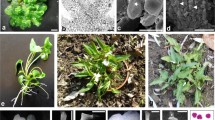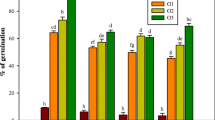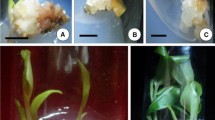Abstract
Glyptostrobus pensilis, a critically endangered plant species worldwide, exhibits low germination rate and consequently poor regeneration ability under natural conditions. In this study, sequence-related amplified polymorphism analysis shows that sexual propagation of this plant species using seeds culture could improve its genetic diversity. Germination trials of seeds at different developmental stages were performed. Seeds sampled at the immature stage in October showed the highest germination rate (19.2%) in vitro, and produced seedlings when cultured on half-strength DCR basal medium. Subsequently, the hypocotyls of seedlings were excised and incubated on callus and shoot induction medium (CSIM), comprising Murashige and Skoog (MS) basal medium supplemented with 2 mg L−1 6-benzyladenine (6-BA) and 0.5 mg L−1 α-naphthaleneacetic acid (NAA). The hypocotyl-derived callus was then used as starting material for shoot regeneration. On average, 2.4 adventitious shoots could be regenerated from a single hypocotyl-derived callus. Furthermore, more than 15 adventitious shoots were obtained from a regenerated adventitious shoot attached to a part of hypocotyl-derived callus, when sub-cultured on CSIM. After rooting and acclimation for 60 days, the plantlets were reintroduced into the conservation area, forming forests of G. pensilis. Thus, we established a circular and highly efficient adventitious shoot regeneration system of G. pensilis using hypocotyl-derived callus as the starting material.
Key Message
This study successfully obtained seedlings of G. pensilis sexual progenies via embryo culture and established a circular and highly efficient adventitious shoot regeneration system using hypocotyl-derived callus as the starting material.







Similar content being viewed by others
Data availability
The data sets generated during and/or analyzed during the current study are available from the corresponding author on reasonable request.
Abbreviations
- 6-BA:
-
6-Benzyladenine
- CSIM:
-
Callus and shoot induction medium
- CTAB:
-
Cetyltrimethyl ammonium bromide
- dNTPs:
-
Deoxynucleotide triphosphates
- GM:
-
Germination medium
- IBA:
-
Indole-3-butyric acid
- NAA:
-
α-Naphthaleneacetic acid
- RM:
-
Rooting medium
- SRAP:
-
Sequence-related amplified polymorphism
References
Alonso P, Moncaleán P, Fernández B, Rodríguez A, Centeno ML, Ordás RJ (2006) An improved micropropagation protocol for stone pine (Pinus pinea L.). Ann For. Sci 63(8):879–885
Anandan R, Prakash M, Deenadhayalan T, Nivetha R, Sumanth Kumar N (2018) Efficient in vitro plant regeneration from cotyledon-derived callus cultures of sesame (Sesamum indicum L.) and genetic analysis of True-to-Type regenerants using RAPD and SSR markers. S Afr J Bot 119:244–251. https://doi.org/10.1016/j.sajb.2018.09.020
Breman E, Ballesteros D, Castillo-Lorenzo E, Cockel C, Dickie J, Faruk A, O’Donnell K, Offord CA, Pironon S, Sharrock S, Ulian T (2021) Plant diversity conservation challenges and prospects—the perspective of botanic gardens and the millennium seed bank. Plants. https://doi.org/10.3390/plants10112371
Businge E (2014) Regulation of metabolic events during embryo development in Norway spruce (Picea abies L. Karst). Acta Universitatis Agriculturae Sueciae
Carneros E, Celestino C, Klimaszewska K, Park YS, Toribio M, Bonga JM (2009) Plant regeneration in stone pine (Pinus pinea L.) by somatic embryogenesis. Plant Cell Tissue Org Cult 98(2):165–178. https://doi.org/10.1007/s11240-009-9549-3
Castander-Olarieta A, Moncaleán P, Montalbán IA (2020) Pinus canariensis plant regeneration through somatic embryogenesis. For Syst 29(1):eSC05. https://doi.org/10.5424/fs/2020291-16136
Chapman T, Miles S, Trivedi C (2019) Capturing, protecting and restoring plant diversity in the UK: RBG Kew and the Millennium Seed bank. Plant Divers 41(2):124–131. https://doi.org/10.1016/j.pld.2018.06.001
Chen L, Zhang M, Xiao Q, Wu J, Hirata Y (2004) Plant regeneration from hypocotyl protoplasts of red cabbage (Brassica oleracea) by using nurse cultures. Plant Cell, Tissue Organ Cult 77(2):133–138
Chen L, Liu K, Wu Y, Cao L, Wang T, Xu D, Yu N, Xiang X, Zhou R, Yu M, Chen D (2019) A method for quick breeding of Abies beshanzuensis employing embryo rescue technology. WO Patent
Dobránszki J, Teixeira da Silva JA (2011) Adventitious shoot regeneration from leaf thin cell layers in apple. Sci Hortic 127(3):460–463. https://doi.org/10.1016/j.scienta.2010.11.003
Fay MF (1992) Conservation of rare and endangered plants using in vitro methods. In Vitro Cell Dev Biol Plant 28(1):1–4. https://doi.org/10.1007/BF02632183
Guan Y, Li S, Fan X, Su Z (2016) Application of somatic embryogenesis in woody plants. Front Plant Sci. https://doi.org/10.3389/fpls.2016.00938
Gupta PK, Durzan DJ (1985) Shoot multiplication from mature trees of Douglas-fir (Pseudotsuga menziesii) and sugar pine (Pinus lambertiana). Plant Cell Rep 4(4):177–179. https://doi.org/10.1007/BF00269282
He L, Zhang J, Guo D, Tian H, Cao Y, Ji X, Zhan Y (2021) Establishment of the technology of cambial meristematic cells (CMCs) culture from shoots and high expression of FmPHV (PHAVOLUTA) functions in identification and differentiation of CMCs and promoting the shoot regeneration by hypocotyl in Fraxinus mandshurica. Plant Physiol Biochem 160(4):352–364. https://doi.org/10.1016/j.plaphy.2021.01.034
Huang H, Wei Y, Zhai Y, Ouyang K, Chen X, Bai L (2020) High frequency regeneration of plants via callus-mediated organogenesis from cotyledon and hypocotyl cultures in a multipurpose tropical tree (Neolamarkia Cadamba). Sci Rep 10(1):4558. https://doi.org/10.1038/s41598-020-61612-z
Ishihara H, Sugimoto K, Tarr PT, Temman H, Kadokura S, Inui Y, Sakamoto T, Sasaki T, Aida M, Suzuki T, Inagaki S, Morohashi K, Seki M, Kakutani T, Meyerowitz EM, Matsunaga S (2019) Primed histone demethylation regulates shoot regenerative competency. Nat Commun 10(1):1786. https://doi.org/10.1038/s41467-019-09386-5
Kaur K, Kaur K, Bhandawat A, Pati PK (2021) In vitro shoot multiplication using meta-Topolin and leaf-based regeneration of a withaferin A rich accession of Withania somnifera (L.) Dunal. Ind Crops Prod 171:113872. https://doi.org/10.1016/j.indcrop.2021.113872
Kumar P, Srivastava DK (2015) High frequency organogenesis in hypocotyl, cotyledon, leaf and petiole explants of broccoli (Brassica oleracea L. var. italica), an important vegetable crop. Physiol Mol Biol Plants 21(2):279–285. https://doi.org/10.1007/s12298-015-0282-6
Li B, Li H, Wang G (2006) Tissue culture and plantlet regeneration of Glyptostrobus pensilis (Lamb.) K. Koch. Plant Physiol Commun 42(06):1136
Liu J, Hong W, Wu Z, Fu D, He Z, Dai L, Lu J (2008) The population life table and periodic fiuctuation of the relict plant Glyptostrobus pensilis. J Wuhan Bot Res 26(03):259–263
Liu K, Liu B, Yuan L, Shuai H, Yang Y, Wang T, Chen D, Chen X, Yang K, Jin X, Chen L (2021) Seed development and embryo culture of endangered Abies beshanzuensis. Chin Bull Bot 56(5):573–583. https://doi.org/10.11983/cbb21096
Mahoney JD, Apicella PV, Brand MH (2018) Adventitious shoot regeneration from in vitro leaves of Aronia mitschurinii and cotyledons of closely related Pyrinae taxa. Sci Hortic 237:135–141. https://doi.org/10.1016/j.scienta.2018.03.062
Murashige T, Skoog F (1962) A revised medium for rapid growth and bio assays with tobacco tissue cultures. Physiol Plant 15(3):473–497. https://doi.org/10.1111/j.1399-3054.1962.tb08052.x
Murray MG, Thompson WF (1980) Rapid isolation of high molecular weight plant DNA. Nucleic Acids Res 8(19):4321–4326. https://doi.org/10.1093/nar/8.19.4321
Owens JN, Kittirat T, Mahalovich MF (2008) Whitebark pine (Pinus albicaulis Engelm.) seed production in natural stands. For Ecol Manag 255(3):803–809. https://doi.org/10.1016/j.foreco.2007.09.067
Pereira C, Montalbán IA, Pedrosa A, Tavares J, Pestryakov A, Bogdanchikova N, Canhoto J, Moncaleán P (2021) Regeneration of Pinus halepensis (Mill.) through organogenesis from apical shoot buds. Forests 12(3):363
Pimm SL, Jenkins CN, Abell R, Brooks TM, Gittleman JL, Joppa LN, Raven PH, Roberts CM, Sexton JO (2014) The biodiversity of species and their rates of extinction, distribution, and protection. Science 344(6187):1246752. https://doi.org/10.1126/science.1246752
Qian L, Chen J, Deng T, Sun H (2020) Plant diversity in Yunnan: current status and future directions. Plant Divers 42(4):281–291. https://doi.org/10.1016/j.pld.2020.07.006
Qin S, Zhang T (2019) The seed ark of Chinese wild plants. Life World 5:26–37
Rohlf JF (1988) NTSYS-pc - Numerical taxonomy and multivariate analysis system. Applied Biostatistics Inc., New York
Sivankalyani V, Takumi S, Thangasamy S, Ashakiran K, Girija S (2014) Punctured-hypocotyl method for high-efficient transformation and adventitious shoot regeneration of tomato. Sci Hortic 165:357–364. https://doi.org/10.1016/j.scienta.2013.11.034
Tam N, Duy V, Bui TTX, Nguyen Minh D (2013) Genetic variation and population structure in Chinese water pine (Glyptostrobus pensilis): a threatened species. Indian J Biotechnol 12(4):499–503
Tang W, Guo Z (2001) In vitro propagation of loblolly pine via direct somatic organogenesis from mature cotyledons and hypocotyls. Plant Growth Regul 33(1):25–31. https://doi.org/10.1023/A:1010764816523
Tang CQ, Yang Y, Momohara A, Wang H-C, Luu HT, Li S, Song K, Qian S, LePage B, Dong YF, Han PB, Ohsawa M, Le BT, Tran HD, Dang MT, Peng MC, Wang CY (2019) Forest characteristics and population structure of Glyptostrobus pensilis, a globally endangered relict species of southeastern China. Plant Divers 41(4):237–249. https://doi.org/10.1016/j.pld.2019.06.007
Thanh ND, Minh Lua DT, Lien QT (2012) Regeneration of complete Glyptostrobus pensilis (Staunton ex D. Don) K. Koch plants from in vitro derived shoots. Acad J Biol 34(2):228–234. https://doi.org/10.15625/0866-7160/v34n2.966
Thomas P, Yang Y, Farjon A, Nguyen D & Liao W (2020) Glyptostrobus pensilis (amended version of 2011 assessment). The IUCN Red List of Threatened Species 2020: e.T32312A177795446. https://dx.doi.org/https://doi.org/10.2305/IUCN.UK.2020-3.RLTS.T32312A177795446.en. Accessed 26 Feb 2022.
Thomas P, LePage B (2011) The end of an era?—The conservation status of redwoods and other members of the former Taxodiaceae in the 21st century. Jpn J Physiol 19:89–100
von Arnold S, Clapham D, Abrahamsson M (2019) Chapter five - embryology in conifers. In: Cánovas FM (ed) Advances in botanical research, vol 89. Academic Press, pp 157–184
Wu Z, Liu J, Hong W, Pan D, Zheng S (2011) Genetic diversity of natural and planted Glyptostrobus pensilis populations: a comparative study. Chin J Appl Ecol 22(04):873–879. https://doi.org/10.13287/j.1001-9332.2011.0085
Ye X, Zhang M, Yang Q, Ye L, Liu Y, Zhang G, Chen S, Lai W, Wen G, Zheng S, Ruan S, Zhang T, Liu B (2022) Prediction of suitable distribution of a critically endangered plant Glyptostrobus pensilis. Forests 13(2):257
Yu N, Cao L, Yuan L, Zhi X, Chen Y, Gan S, Chen L (2018) Maintenance of grafting-induced epigenetic variations in the asexual progeny of Brassica oleracea and B. juncea chimera. Plant J 96(1):22–38. https://doi.org/10.1111/tpj.14058
Zhang H, Lang Z, Zhu J-K (2018) Dynamics and function of DNA methylation in plants. Nat Rev Mol Cell Biol 19(8):489–506. https://doi.org/10.1038/s41580-018-0016-z
Acknowledgements
We thank Dr. Yingang Li of Zhejiang Academy of Forestry and Mr. Weizhong Shao of Jiande Forestry Centre for assistance in reintroduction.
Funding
This study was supported by the Zhejiang Province Key Research and Development Program (2019C02026) and the National Natural Science Foundation of China (Grant No. 31870320).
Author information
Authors and Affiliations
Contributions
Conceptualization, L.Y., L.X. and L.C.; Methodology, L.Y., L.X. and L.C.; Resources, L.Y., T.W., D.X., B.L. and R.C.; Investigation, L.Y., S.M., K.L. and A.Z.; Formal analysis, L.Y., S.M and L.C; Writing—Original Draft and Review & Editing, L. Y and L. C.
Corresponding author
Ethics declarations
Competing interest
The authors declare that they have no conflict of interest.
Additional information
Communicated by Paloma Moncaleán.
Publisher's Note
Springer Nature remains neutral with regard to jurisdictional claims in published maps and institutional affiliations.
Supplementary Information
Below is the link to the electronic supplementary material.
Rights and permissions
Springer Nature or its licensor (e.g. a society or other partner) holds exclusive rights to this article under a publishing agreement with the author(s) or other rightsholder(s); author self-archiving of the accepted manuscript version of this article is solely governed by the terms of such publishing agreement and applicable law.
About this article
Cite this article
Yuan, L., Ma, S., Liu, K. et al. High frequency adventitious shoot regeneration from hypocotyl-derived callus of Glyptostrobus pensilis, a critically endangered plant. Plant Cell Tiss Organ Cult 152, 139–149 (2023). https://doi.org/10.1007/s11240-022-02396-0
Received:
Accepted:
Published:
Issue Date:
DOI: https://doi.org/10.1007/s11240-022-02396-0




